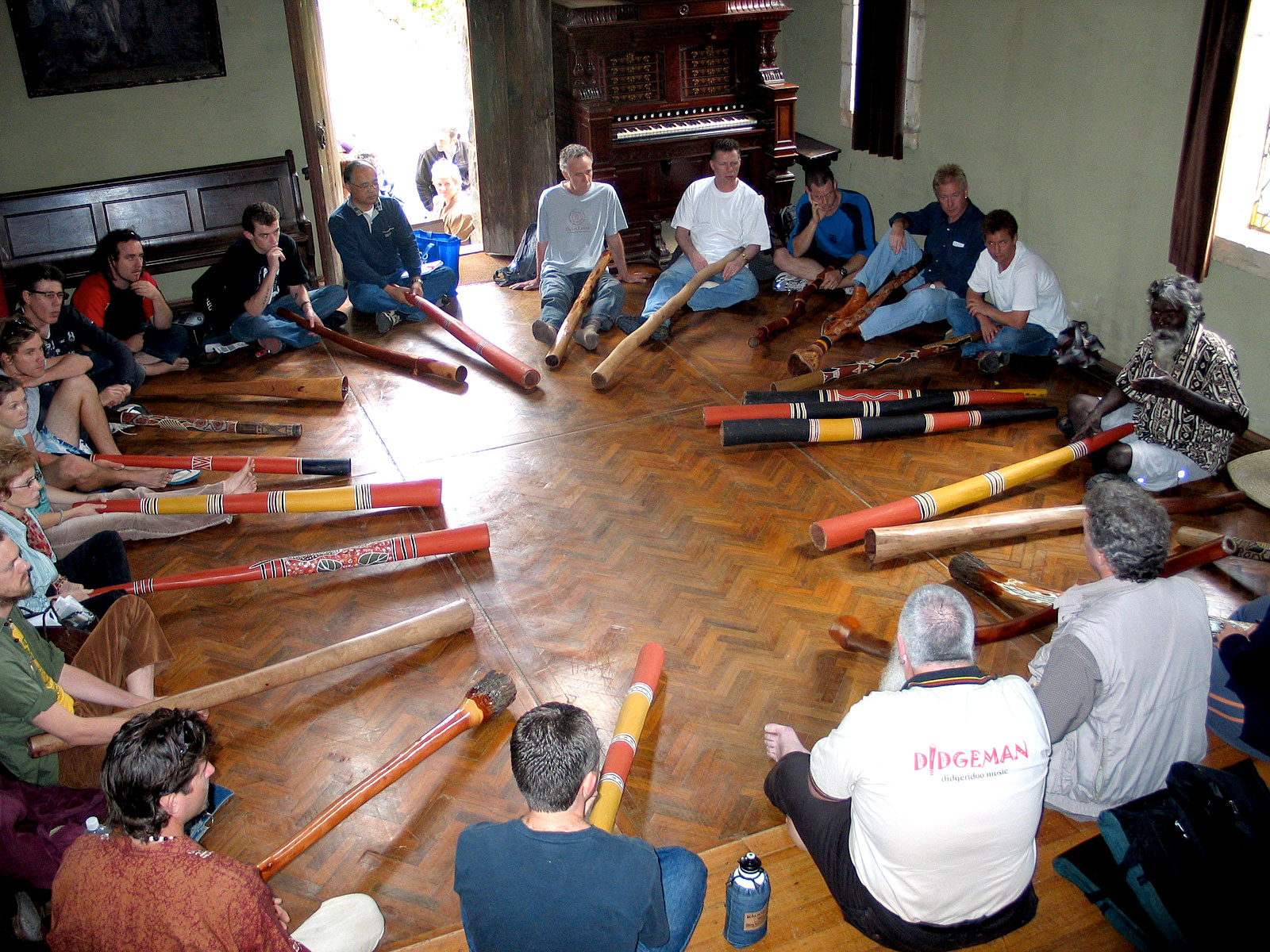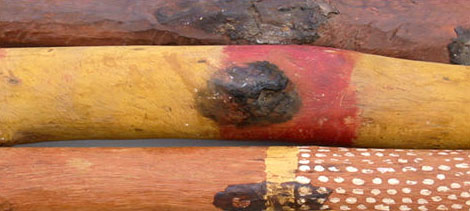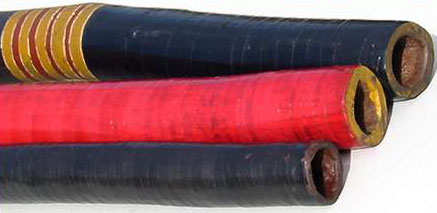.
 In the Aboriginal cultures of northern Australia, a good didgeridoo is highly coveted due to the fact that instruments with the correct sonic characteristics are rare and difficult to find. Consequently, there is much excitement and a general uplifting of spirit in the community when a good instrument is found and made, and it would not be unusual for the didgeridoo to be immediately borrowed by players in the area eager to test it out. From the start, efforts are made to prolong the life of a good instrument. This may be something as simple as coating the instrument’s body with a wash of ochre or a mixture of plant resin and ochre, though it is more common these days to ‘seal’ the outside of the instrument with a coating of PVA glue. Attention would also be given to any air leaks, which are patched with plugs of native beeswax, plant resins, or the choice of other materials from the hardware store.
In the Aboriginal cultures of northern Australia, a good didgeridoo is highly coveted due to the fact that instruments with the correct sonic characteristics are rare and difficult to find. Consequently, there is much excitement and a general uplifting of spirit in the community when a good instrument is found and made, and it would not be unusual for the didgeridoo to be immediately borrowed by players in the area eager to test it out. From the start, efforts are made to prolong the life of a good instrument. This may be something as simple as coating the instrument’s body with a wash of ochre or a mixture of plant resin and ochre, though it is more common these days to ‘seal’ the outside of the instrument with a coating of PVA glue. Attention would also be given to any air leaks, which are patched with plugs of native beeswax, plant resins, or the choice of other materials from the hardware store.
In past times, instruments that are not in use are sometimes maintained by keeping them constantly moist in a creek or waterhole. This has two functions: to prevent wood shrinkage and the consequent splitting of the didgeridoo in dry air, and to ensure the instrument is well primed for use when the need arises. In more contemporary times, it is far more common for didgeridoos to be kept in family dwellings such as within a house or underneath a bush shelter. Priming instruments stored in this way merely requires sluicing the bore with water for a few minutes. This is also done during ceremonial performances or during recreational playing to ensure the bore of the instrument is constantly wet and that the sound of the instrument is optimised.
Didgeridoos used frequently for ceremonial events or recreational purposes often develop air leaks due to the wet-dry cycle that the instruments are put through. These are again patched as required. For more extensive cracks, a contemporary method for preventing air leakage during playing is the use of electrical tape wound around the length of the instrument. This is similar to an old method for extending an instrument’s lifespan using a wrap of paperbark, secured with bush string, which covers the whole instrument keeping it airtight. Whilst in theory a didgeridoo could be used indefinitely through constant repair and maintenance, the lifespan of a didgeridoo in Aboriginal society is usually 2 to 3 years. A good instrument that has been used extensively, and displaying the battle scars (electrical tape and all) endured during its lifetime, is as highly cherished as a good new instrument in prime condition. However, when it becomes too troublesome to maintain an old instrument – usually because it leaks too much air – then a suitable replacement is found for it and the old one discarded. There is no sentimentality associated with this as material possession in Aboriginal society is something quite different to Western society’s notion of wealth and status.



 A didgeridoo is very easy to repair. Should your instrument develop air leaks, an electrical tape job does the trick if you are not bothered with the change in aesthetics. If you do want to preserve the look of your instrument, there are some simple repair techniques that would restore your instrument to full glory. The most effective and fastest method for patching a split is with PVA glue mixed with fine sawdust or charcoal. Combine the sawdust or charcoal with an amount of glue and mix until a soft putty-like substance is formed. If the putty is too liquid, mix more sawdust or charcoal as required. If the putty is too stiff or crumbly, add more glue. Lightly sand the area on your didgeridoo that is cracked with a fine-grade sandpaper, and then push the putty into the crack ensuring no air leaks remain. When the putty has hardened (best to leave for 72 hours), sand it back to the level of the wood and your didgeridoo should be as good as new. A stronger glue such as a two-part epoxy resin may be used in place of PVA glue, but be sure to read the label and any health warnings the product might have. Touching up or restoring the artwork on instruments is easy if the correct colours can be found; your local state or national museum might have information on specialist restorers that can do this for you.
A didgeridoo is very easy to repair. Should your instrument develop air leaks, an electrical tape job does the trick if you are not bothered with the change in aesthetics. If you do want to preserve the look of your instrument, there are some simple repair techniques that would restore your instrument to full glory. The most effective and fastest method for patching a split is with PVA glue mixed with fine sawdust or charcoal. Combine the sawdust or charcoal with an amount of glue and mix until a soft putty-like substance is formed. If the putty is too liquid, mix more sawdust or charcoal as required. If the putty is too stiff or crumbly, add more glue. Lightly sand the area on your didgeridoo that is cracked with a fine-grade sandpaper, and then push the putty into the crack ensuring no air leaks remain. When the putty has hardened (best to leave for 72 hours), sand it back to the level of the wood and your didgeridoo should be as good as new. A stronger glue such as a two-part epoxy resin may be used in place of PVA glue, but be sure to read the label and any health warnings the product might have. Touching up or restoring the artwork on instruments is easy if the correct colours can be found; your local state or national museum might have information on specialist restorers that can do this for you.